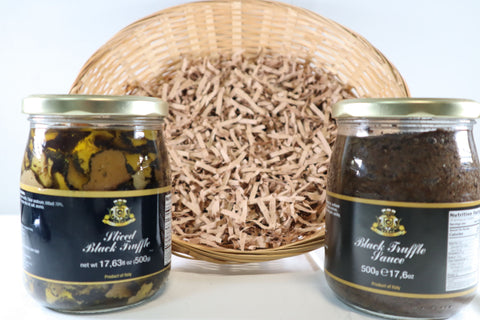An Exploration of Two Exquisite Truffle Preparations
Truffles, often dubbed the "diamonds of the kitchen," have captivated food enthusiasts for centuries with their earthy, complex flavor profile and elusive nature. Among the numerous truffle-based delicacies, Truffle Tartufata and Truffle Carpaccio stand out as two distinct yet exquisite preparations. While both celebrate the rich and indulgent essence of truffles, they cater to different culinary uses and taste experiences. In this article, we'll dive into the differences between Truffle Tartufata and Truffle Carpaccio, exploring their origins, uses, recipes, and flavors.
The Origins of Truffles
Truffles are subterranean fungi belonging to the genus Tuber, typically found in symbiotic association with the roots of certain trees. Known for their distinct aroma, truffles are a delicacy that has been revered since ancient times, particularly in Mediterranean cuisine. The most prized varieties are the black truffle (Tuber melanosporum) and the white truffle (Tuber magnatum), both of which are highly sought after during their respective harvesting seasons.
-
Black Truffles: Found primarily in southern France and parts of Italy, black truffles are harvested from late autumn to early spring.
-
White Truffles: Predominantly sourced from the Piedmont region in Italy, white truffles are typically hunted from late September through December.
With such rarity and a short harvesting window, truffles command premium prices, making them a luxurious addition to gourmet dishes.
Truffle Tartufata: An Earthy Infusion
What is Truffle Tartufata?
Truffle Tartufata is a rich, flavorful spread made primarily from black truffles, mushrooms, and olive oil, often combined with herbs, spices, and other ingredients like garlic and cheese. The resulting blend is a versatile condiment that encapsulates the robust essence of truffles while adding depth from the mushrooms.
Culinary Uses
Truffle Tartufata is perfect for a variety of applications:
- Spread it on crostini or bruschetta for a sophisticated appetizer.
- Mix it into pasta dishes to elevate creamy sauces.
- Incorporate it into risottos or polentas for added umami.
- Use it to season meats or vegetables, providing an earthy undertone.
Recipe Idea: Truffle Tartufata Pasta
Ingredients:
- 200g spaghetti
- 2 tablespoons Truffle Tartufata
- 2 tablespoons olive oil
- 50g grated Parmesan cheese
- Salt and freshly cracked pepper
- Fresh parsley for garnish
Instructions:
- Cook spaghetti according to package instructions until al dente.
- In a pan, heat olive oil over medium heat. Add Truffle Tartufata and stir for a minute.
- Drain the pasta, reserving some cooking water, and add it to the pan.
- Toss to combine, adding Parmesan cheese and reserved pasta water as necessary to achieve creaminess.
- Season with salt and pepper, and garnish with fresh parsley before serving.
Flavor Profile
Truffle Tartufata is characterized by its deep, earthy tones and a balanced umami punch, making it a wonderfully savory option that can enhance a wide variety of dishes.
Truffle Carpaccio: Delicate Elegance
What is Truffle Carpaccio?
Truffle Carpaccio, on the other hand, is a dish that evokes the luxury of raw truffles displayed in their purest form. Thinly sliced fresh truffles are layered over various bases, often accompanied by a drizzle of high-quality olive oil, salt, and sometimes accompaniments like microgreens or Parmesan shavings.
Culinary Uses
Truffle Carpaccio is commonly used as:
- A topping for steak or fish, providing a flavor contrast to the dish.
- An elegant addition to salads, where the truffle’s unique aroma can shine through.
- A sophisticated antipasto dish, served alongside cheese or cured meats.
Recipe Idea: Truffle Carpaccio Salad
Ingredients:
- 100g fresh white truffles, finely sliced
- Mixed baby greens
- 2 tablespoons high-quality olive oil
- Sea salt to taste
- Freshly cracked black pepper
- Lemon wedges (for drizzling)
Instructions:
- Place the mixed greens on a serving plate.
- Arrange the thinly sliced truffles over the greens.
- Drizzle with olive oil and sprinkle with sea salt and black pepper.
- Serve with lemon wedges on the side to enhance the flavor.
Flavor Profile
Truffle Carpaccio offers an unparalleled tasting experience; the freshness of the raw truffles allows their complex, aromatic flavors to emerge fully. The result is a luxurious dish with a delicate touch, allowing the true essence of truffles to shine.
Conclusion: Choosing Between Traditions
When it comes to using truffles in your culinary endeavors, both Truffle Tartufata and Truffle Carpaccio have their unique attributes. Truffle Tartufata provides a robust, earthy blend that blends beautifully into complex dishes and spreads. In contrast, Truffle Carpaccio offers an elegant experience, allowing you to appreciate truffles' raw, unadulterated flavors.
By understanding these two preparations, you can elevate your culinary repertoire and explore the countless ways to enjoy the luxurious experience that truffles have to offer. Whether you choose the indulgent richness of Tartufata or the sophisticated simplicity of Carpaccio, truffles are sure to bring your dishes to a whole new level of gourmet delight.


